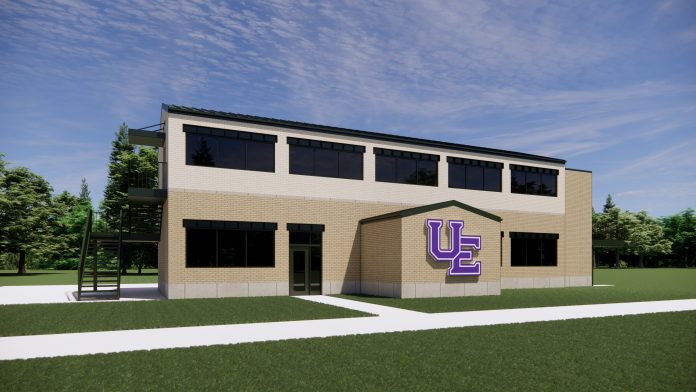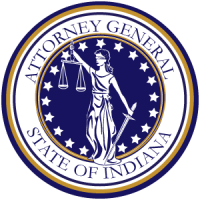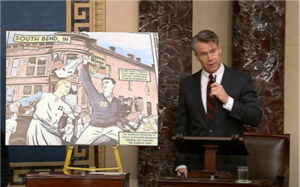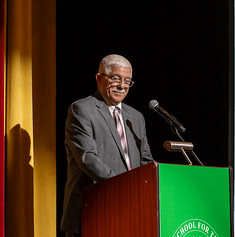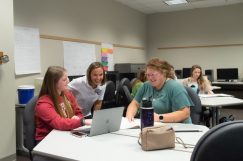|
|||||||||||||
|
|||||||||||||
|
|||||||||||||
|
|||||||||||||
|
|||||||||||||
|
|||||||||||||
|
|||||||||||||
|
|||||||||||||
|
|||||||||||||
|
HOT JOBS
UE’S DEVERMAN EARNS MVC FRESHMAN OF THE YEAR; FOUR ACES NAMED ALL-VALLEY
Freeland Family Donates $3 million to UE Baseball Program
EVANSVILLE, Ind. – The University of Evansville (UE) is elated to announce that Kyle ’15 and Ashley ’15 Freeland have generously contributed approximately $3 million to facilitate the establishment of a baseball clubhouse for the University which will be known as The Freeland Clubhouse. This is believed to be the largest gift in UE Athletics history. The Freeland’s philanthropic gesture will serve as the cornerstone for the initiation of the clubhouse project, a pivotal component of UE’s comprehensive athletics strategic plan, Pathway to Excellence.
Head Baseball Coach Wes Carroll has diligently cultivated a culture of excellence within UE’s baseball program. In a resounding testament to their unwavering support for Coach Carroll’s strategic vision for the future of UE Men’s Baseball, the Freeland’s have earmarked this gift for the construction of the new facility which will be situated close to the German American Bank Field at Charles H. Braun Stadium. The facility will include a locker room, offices for coaching staff, and space for a lounge. It is slated to be completed sometime in Summer 2025.
Kyle Freeland, a distinguished pitcher for the Colorado Rockies, honed his skills as a member of the UE Baseball team before being drafted in 2014. Meanwhile, his wife, Ashley Freeland, herself a former student-athlete at UE, attained her Bachelor of Science in Sport Management in 2015.
“It’s truly an honor for myself and my wife Ashley to be able to give back to the University of Evansville and support this baseball program into the future. I owe so much of my development as a baseball player and a person to my time at UE and Coach Wes Carroll, and this felt like the most fitting way for me to say thank you,” said Kyle Freeland ’15. “This program has built and sustained success for many years, and our goal with this gift to the baseball program is to help build on that momentum, create a team-oriented environment that helps Evansville baseball players realize their true potential as students and athletes, and continue to boost recruiting. We’re already excited to cut that ribbon and see the future of Purple Aces baseball.”
At a Monday morning press conference, Director of Athletics Dr. Kenneth “Ziggy” Siegfried said it was very clear that Coach Carroll made a difference in the life of Kyle Freeland and the family has decided to extend that influence by supporting future Aces.
“Aces Baseball is on the rise, and this transformational gift by Kyle and Ashley Freeland further accelerates our success in the Missouri Valley Conference and nationwide. I have always stated that we are a sleeping giant at the University of Evansville. A big part of that is the fact that we have Purple Aces like Kyle and Ashley Freeland who are willing to invest in our future,” said Dr. Siegfried. “I am so happy for Coach Wes Carroll and our UE Baseball program. Coach Carroll embodies what it means to be a Purple Ace. He has set the vision for the future of the UE Baseball program, and at the center of that vision has been a focus on our student-athletes.”
Watch For Signs Of Human Trafficking At Indy 500
Attorney General Todd Rokita Warns Race Fans About Human Trafficking
May 21, 2024
As the Greatest Spectacle in Racing, the Indianapolis 500 is unparalleled as an international sporting event. Unfortunately, large events are known to create increased demand for trafficked individuals providing manual labor, sex for hire and other services. Attorney General Todd Rokita asks Hoosiers to know the signs, stay alert and report any suspicion to law enforcement.
“Spectator events of such grand scale are ripe for human traffickers looking for opportunities to carry out their heinous crimes,” Attorney General Rokita said. “As we excitedly participate in the greatest spectacle in racing, we need to keep our eyes and ears open for human trafficking as well. By reporting suspicions to local law enforcement, we can help authorities nab these predators and save victims.”
Following are signs that someone might be a victim of trafficking:
- They appear submissive or fearful.
- They are prohibited from speaking alone to strangers.
- They give answers that appear to be scripted or rehearsed.
- They show signs of physical abuse.
“Human traffickers can prey on anyone, regardless of their age, race or background,” Attorney General Rokita said. “It’s up to all of us to play a role in shutting down this devastating criminal enterprise.”
People in certain job roles — such as medical professionals, restaurant workers, and hotel employees — are particularly likely to come into contact with trafficking victims.
If you have suspicions that someone is being trafficked, call local law enforcement immediately. You may also report suspicions to the National Human Trafficking Hotline at 1-888-373-7888.
In addition to raising awareness, Attorney General Rokita and his team are engaged in other efforts to combat human trafficking.
The Office of the Attorney General operates the Address Confidentiality Program, which helps protect victims of certain crimes — including those who have been trafficked — by concealing their residential address from the public and thereby their victimizers. Learn more about the program at the Attorney General’s website.
In February, Attorney General Rokita announced all K-5 students in Indiana would receive a child ID kit in 2024 — free of charge to Indiana families. Child ID kits give parents a tool to provide detailed information, a photograph, fingerprint, and DNA to law enforcement quickly. Completed kits are kept in a safe place at home, out of a database, so parents are prepared if the unthinkable happens. Kits will be distributed by superintendents and school resource officers to students this fall.
As it happens, this year the Indianapolis 500 race weekend coincides with National Missing Children’s Day, which is May 25. The day is intended to encourage parents, guardians, and communities to make child safety a priority — and as a reminder to continue our efforts to reunite missing children with their families.
FOOTNOTE; THE CITY-COUNTY OBSERVER POSTED THIS ARTICLE WITHOUT OPINION. BIAS, OR EDITING.
Superintendent James Durst to retire this fall
INDIANAPOLIS – Governor Eric J. Holcomb today announced Superintendent James Durst will retire from the Indiana School for the Blind and Visually Impaired (ISBVI) effective September 30, after serving the ISBVI for 33 years in leadership roles.
“I’m so grateful for the decades Superintendent Durst spent as a dedicated educational leader serving Hoosiers who are blind and visually impaired as well as their families and wider communities,” said Gov. Holcomb. “In recent years, he prepared the Indiana School for the Blind and Visually Impaired for major upcoming capital improvements, including the eventual world class co-location of the Indiana School for Deaf on its campus.”
Durst was appointed Superintendent of the ISBVI in 2001 following 10 years of service as principal at the school. He also had over a decade of teaching and educational leadership in West Virginia.
As one of the largest state schools in the nation serving students who are blind or have low vision, IBSVI enrolls 110 students spanning preschool through high school, approximately 40 of whom are residential, as well as directly serving over 300 students across 46 school districts. The school offers a wide array of other programming aligned to its statutory mission of serving Hoosier students with visual disabilities.
During his tenure at the school, Durst was instrumental in the following accomplishments:
- Reorganized and expanded the school’s Outreach Program, Short Course Program and summer programs and camps to serve hundreds of students across multiple school districts.
- Completed numerous capital and technology projects on campus, including the complete renovation of the school’s 1920s era auditorium with the support of the Indiana Blind Children’s Foundation and Lilly Endowment, Inc.
- The renaming of the school from the Indiana School for the Blind to the Indiana School for the Blind and Visually Impaired.
- Implementation of the Unified English Braille code and proficiency requirements for teachers.
- Served as president for two national organizations, the Council of Schools for the Blind and the Principals of Schools for the Blind.
- Developing comprehensive strategic plans and the current five-year strategic plan through 2027.
- Planning and preparation for the eventual co-location of the Indiana School for the Deaf on ISBVI’s campus, including the multiyear continuation of operations offsite beginning the 2024-2025 school year as the campus undergoes extensive renovations and construction.
- Established a statewide prison braille program in collaboration with the Indiana Department of Correction to employ incarcerated adults at Miami Correctional Facility to transcribe and provide low-cost braille, large print, and accessible formats for school-age children.
“I would like to express my sincere gratitude for the support and collaboration you have provided to me and the school as board members,” said James Durst. “Our shared commitment to providing an outstanding education for the students at the Indiana School for the Blind and Visually Impaired has been the driving force behind our accomplishments.”
THR PATH OF TOTALITY
PATH OF TOTALITY
MAY 21, 2024
On April 8, 2024, Americans in every state had the chance to witness either a partial or total solar eclipse. Solar eclipses materialize when the moon passes between the earth and the sun, casting a shadow on the Earth’s surface and partially or fully obstructing the sun from view.
Despite the relative frequency of solar eclipses, occurring approximately two to four times a year, the geographic path of totality—the region where viewers can experience the complete blockage of the sun—is small. Consequently, for individuals in any given location, the opportunity to observe a total solar eclipse is an extremely rare event. NASA notes that, on average, this phenomenon occurs roughly once every hundred years. However, some regions may experience total solar eclipses more frequently.
For instance, the most recent total solar eclipse visible in the U.S. took place in 2017, with the path of totality extending from Oregon to South Carolina. Prior to 2017, only two solar eclipses in the 20th century had totality paths that overlapped some portion of the United States. Looking ahead, the next coast-to-coast total solar eclipse won’t occur until 2045.
The 2024 Solar Eclipse Path of Totality
The April 8th solar eclipse path of totality stretches from Texas to Maine
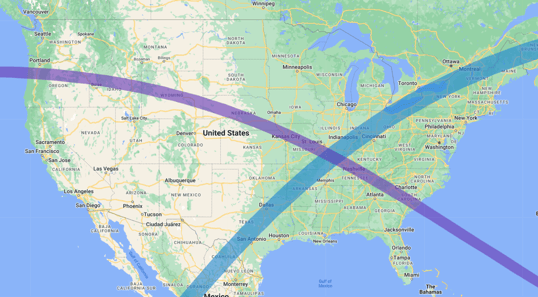
Source: Captain Experiences analysis of NASA data shown on Google Maps. The 2024 totality path is shown in blue; the 2017 totality path is shown in purple.
Compared to the 2017 total solar eclipse, the upcoming 2024 event will boast a wider and more populated path of totality. While the totality path in 2017 averaged 60–70 miles in width, the 2024 eclipse will span approximately 110–120 miles.
Moreover, the path of totality for the 2024 eclipse encompasses a greater number of major U.S. cities compared to that of 2017—notably, several large cities in Texas. As a result, an estimated 31 million Americans will find themselves within the path of totality for the 2024 event, substantially more than the 12 million in 2017. Residents in 15 states—Texas, Oklahoma, Arkansas, Missouri, Tennessee, Illinois, Kentucky, Indiana, Ohio, Michigan, Pennsylvania, New York, Vermont, New Hampshire, and Maine—will have the opportunity to witness the moon completely blocking the sun’s view in 2024.
RELATED
Get ready for an unforgettable fishing adventure that will leave you hooked on New York’s fishing scene. Our New York fishing guides are fully licensed and insured, and can provide an array of options to suit every angler’s preference and skill level.
Largest U.S. Cities in the 2024 Solar Eclipse Totality Path
Texas is home to the top 4 largest cities in the path of totality
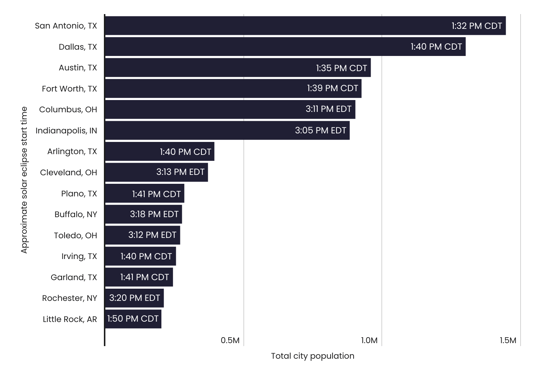
Due to the unique path of the 2024 eclipse, Texas stands out as the state hosting the top four largest cities within the totality path and eight of the top 15. Notably, among the five largest cities in Texas—Houston, San Antonio, Dallas, and Austin—only Houston will not experience the total solar eclipse this year. Similarly, in Ohio, three out of its top four cities fall within the 2024 path of totality, including Columbus, Cleveland, and Toledo. Other major U.S. cities within the totality path are Indianapolis, IN, Buffalo, NY, Rochester, NY, and Little Rock, AR.
Another unique characteristic of the 2024 eclipse is that several large U.S. cities lie in close proximity to, though not directly within, the totality path. Residents in these cities will still have the opportunity to witness a nearly total eclipse. For instance, individuals in Memphis, TN, St. Louis, MO, Louisville, KY, Cincinnati, OH, and Pittsburgh, PA can all expect to experience at least a 95% partial eclipse.\
TRENDING
Whether you’re craving the tranquility of lake fishing, the thrill of nearshore adventures, or the excitement of river excursions, our expert fishing guides in Cleveland have you covered. Choose between full-day expeditions for a deep dive into angling, or half-day trips for a quick yet rewarding fishing getaway.
Population Living in the Path of Totality by State
While Texas has the most residents overall living in the path of totality, Ohio has the highest proportion
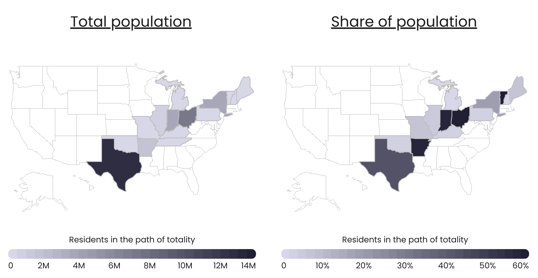
Captain Experiences analysis of NASA and Census data
In terms of total population within the path of totality, Texas leads with 12.6 million residents, followed by Ohio (7.1 million), Indiana (3.9 million), and New York (3.6 million). However, when considering the states with the highest proportion of residents within the totality path, Ohio, Vermont, Arkansas, and Indiana are this year’s frontrunners. In each of these four states, more than 57% of the population resides in areas where the total eclipse will be visible.
Conversely, only tiny slivers of Michigan and Tennessee fall within the totality path. Fewer than 10,000 residents in Michigan and fewer than 1,000 residents in Tennessee are estimated to live in areas where the total eclipse can be observed.
For Americans living outside of these areas, the April 8th event will still be worth watching—albeit using eclipse safety glasses the entire time. With the exception of Florida, most East Coast residents will be able to observe a partial eclipse with 70%–90% obscuration. Maximum obscuration in Florida ranges from approximately 45%–75%. West of the totality path, obscuration will decrease the further west and north one lives. On the West Coast, maximum obscuration ranges from around 55% in San Diego to 20% in Seattle.
LEARN MORE
From serene lake fishing to chasing after alligator gars on the local rivers and creeks, our expert fishing guides near Dallas, TX offer a variety of trips to cater to your angling desires.
Methodology
This study was conducted by Captain Experiences using data from NASA’s Scientific Visualization Studio and from the U.S. Census Bureau’s 2020 TIGER/Line Shapefiles and 2022 American Community Survey 5-Year Estimates. To determine the states with the most people living in the path of totality for the 2024 solar eclipse, researchers identified the Census tracts in each state that overlap fully or partially with the totality path. Populations for the resulting census tracts were summed and divided by the state total population. For Census tracts that only partially overlap, populations were reduced based on the percentage of the Census tract’s area outside of the totality path.
To identify the largest places (cities, villages, boroughs, etc.) that fall within the path of totality, researchers identified the Census places that overlap fully or partially with the totality path. Only places with a 10% or more overlap with the totality path were included. Additionally, places with fewer than 1,000 people were filtered out. The approximate start time for each place was calculated by merging the Census places shapefiles with NASA’s umbra 10-second interval shapefiles, and selecting the earliest time that intersected with each place. Times were converted to Central Daylight Time or Eastern Daylight Time depending on the location.
References
The National Aeronautics and Space Administration. (2024). Eclipse 101. Retrieved on March 20, 2024 from https://eclipse2017.nasa.gov/faq. Almanac. (2024). Eclipse History: Total Solar Eclipses in the United States. Retrieved on March 20, 2024 from https://www.almanac.com/eclipse-history-total-solar-eclipses-united-states. The National Aeronautics and Space Administration. (2024). Eclipse Safety. Retrieved on March 20, 2024 from https://science.nasa.gov/eclipses/safety/. The National Aeronautics and Space Administration. (2023, July 10). The 2024 Total Solar Eclipse. Retrieved on March 20, 2024 from https://svs.gsfc.nasa.gov/5123/. The National Aeronautics and Space Administration. (2024). Scientific Visualization Studio. Retrieved on March 20, 2024 from https://svs.gsfc.nasa.gov/. U.S. Census Bureau. (2024). TIGER/Line Shapefiles. Retrieved on March 20, 2024 from https://www.census.gov/geographies/mapping-files/time-series/geo/tiger-line-file.2020.html. U.S. Census Bureau. (2024). American Community Survey [Data set]. They were retrieved on March 20, 2024 from https://www.census.gov/programs-surveys/acs.
USI Pott College of Science, Engineering, and Education recognized as CAEP accredited program
The University of Southern Indiana’s Educator Preparation Program (EPP), spanning two Colleges and numerous majors and minors, has received a seven-year extension on its accreditation from the Council for the Accreditation of Educator Preparation (CAEP).
The EPP is housed in the Pott College of Science, Engineering, and Education and the College of Liberal Arts, including majors and minors such as elementary education, special education, early childhood education, mathematics, history and more.
CAEP’s mission is to advance equity and excellence in educator preparation through evidence-based accreditation that assures quality and supports continuous improvement to strengthen P-12 learning.
“We are very proud that our Educator Preparation Program has once again earned national recognition from the Council for the Accreditation of Educator Preparation,” says Dr. Tori Colson, Assistant Dean of the Pott College of Science, Engineering, and Education and Interim Chair of Teacher Education. “This recognition is a testament to our commitment to excellence in high-quality teacher preparation and dedication to ensure our graduates are well-prepared to make significant contributions in the classroom.”
In addition to preparing students for careers in education, accreditation provides a framework that pushes educator preparation programs to continually self-assess and conduct evidence-based analysis of their programs and their efficacy.
“National accreditation by CAEP is critical to our teacher preparation programs in the Pott College to ensure quality classroom instruction, meaningful clinical experiences and rewarding professional development,” says Dr. William Elliott, Interim Dean of the Pott College of Science, Engineering, and Education. “This renewal serves as a mark of quality, demonstrating that USI’s Teacher Education Programs meet rigorous standards and prepare future educators effectively for their roles in the classroom.”




